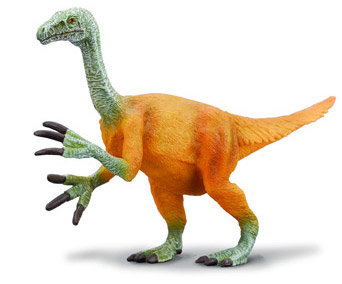New Species of Nothronychus Discovered in Utah
Say Hello to Nothronychus graffami
A New Species of Nothronychus
The discovery of the most complete fossilised skeleton of a species of Nothronychus in the United States has been announced in the online scientific publication the Journal of Proceedings of the Royal Society B: Biological Sciences. It is hoped that this new fossil of a therizinosaurid (scythe lizards), discovered in southern Utah, will help improve our understanding of these bizarre theropod dinosaurs.
The therizinosaurid group (pronounced Ther-ih-zine-oh-sore-id), are theropod dinosaurs a suborder of the Saurischia which possess adaptations for plant-eating, although many of their relatives were fierce meat-eaters. Hopefully, the fossils of this new species Nothronychus graffami may help explain how these animals evolved such characteristics and where in the Late Cretaceous ecosystem they fitted.
Such fossil remains may provide evidence of the evolution of vegetarian theropods, an adaptation that may be older than previously thought. Famous predatory dinosaurs such as the dromaeosaurs (Troodon and Velociraptor for example), may have evolved from less fearsome, plant-eating ancestors.
Nothronychus graffami
N. graffami was named after Merle Graffam a member of the University of Northern Arizona’s excavation team who first discovered the beautifully preserved fossil remains of this 4-metre-high dinosaur. The fossil skeleton has been dated to approximately 93 million years ago (Cenemanian faunal stage) and the scientists estimate that this species of Nothronychus pre-dates the other Nothronychus species known from the United States Nothronychus mckinleyi. When N. mckinleyi was formerly named and described in 2001, it became the first therizinosaurid to have lived outside of Asia. It is likely that these strange sloth-like animals (Nothronychus means “sloth-like claw”),evolved in Asia and migrated into other parts of the northern hemisphere during the Cretaceous.
The small head, had a beak, this was perched on a long, slender neck. The teeth are leaf shaped and adapted to eating tough plant material. The heavy, pot-belied body with broad hips was carried along by short stumpy hind legs, the strong arms ended in three-clawed hands. The claws are very characteristic of “scythe lizards”, indeed this is how this particular group of dinosaurs got their name. In the case of N. graffami, the three fingered hands ended in broad, claws over 20 cm long.
New Dinosaur Species
It is believed that therizinosaurs may have been covered in primitive feathers and that they may have lived like giant sloths, using their strong, powerful claws to pull down branches so that they could graze on the leaves.
Commenting on the strange-looking creature Lindsay Zanno of the Field Museum in Chicago stated:
“It takes a lot of gut-time to digest plants, plant-eaters have to develop long digestive tracts to get the energy they need to survive”.
Pictures show the restored and mounted manus (hand) of this dinosaur, the curved, sickle-like claws can be clearly seen. Scientists believe that the therizinosaurids are a type of maniraptoran dinosaur, although most maniraptoran dinosaurs are believed to have been meat-eaters this new fossil has helped shed light on the evolution of the group as a whole.
The Evolution of Theropods
In a bid to find out more information regarding the evolution of theropods and in particular the herbivorous forms, Dr Zanno and her colleagues compared the anatomy of the newly discovered genus of Nothronychus with specimens from seventy-five other types of theropod. Their research indicates that the therizinosaurids are perhaps the most primitive group of maniraptorans. This could mean that maniraptorans also originated in Asia, before migrating across the ancient dinosaur world.
The team conclude that plant-eating may have been a trait of early maniraptorans, certainly several types of maniraptoran dinosaur show adaptations for a partial herbivorous or at least an omnivorous habit. The ornithomimosaurs and the oviraptorids are examples of this type of dinosaur with adaptations for a non meat specific diet.
Dr Zanno commentated:
“Before this we thought that plant-eating theropods like therizinosaurs were a rare occurrence. We knew they must have evolved from meat-eaters somewhere in their ancestry, but before our study it seemed like plant-eating was the exception not the norm for maniraptoran theropods”.
Studying the Maniraptora
Rather than being the exception to the meat-eating rule, Dr Zanno and her fellow researchers claim that eating plants exclusively or in combination with meat can be traced back to the origins of the maniraptoran group as a whole. It is possible that many types of maniraptoran dinosaurs ate some portion of vegetable matter in their diets, an inherited trait from the common ancestor of the whole maniraptoran group, the scientists state. The American based team have speculated that the ability to eat plant matter may have allowed the maniraptorans to migrant to new areas and exploit new niches in the Mesozoic ecosystem as plants themselves evolved. This may help to explain their variety and diversity.
The therizinosaurs are certainly very strange animals, although these new fossils will help shed more light on the group they remain very enigmatic and extremely rare in the fossil record.
Model makers are beginning to recognise the therizinosaurs and recently a number of models of these types of dinosaur, including a Nothronychus have been introduced.
The CollectA Nothronychus Model

Picture credit: Everything Dinosaur
To view the model of the Nothronychus and other feathered dinosaurs: CollectA Prehistoric Life Models.

